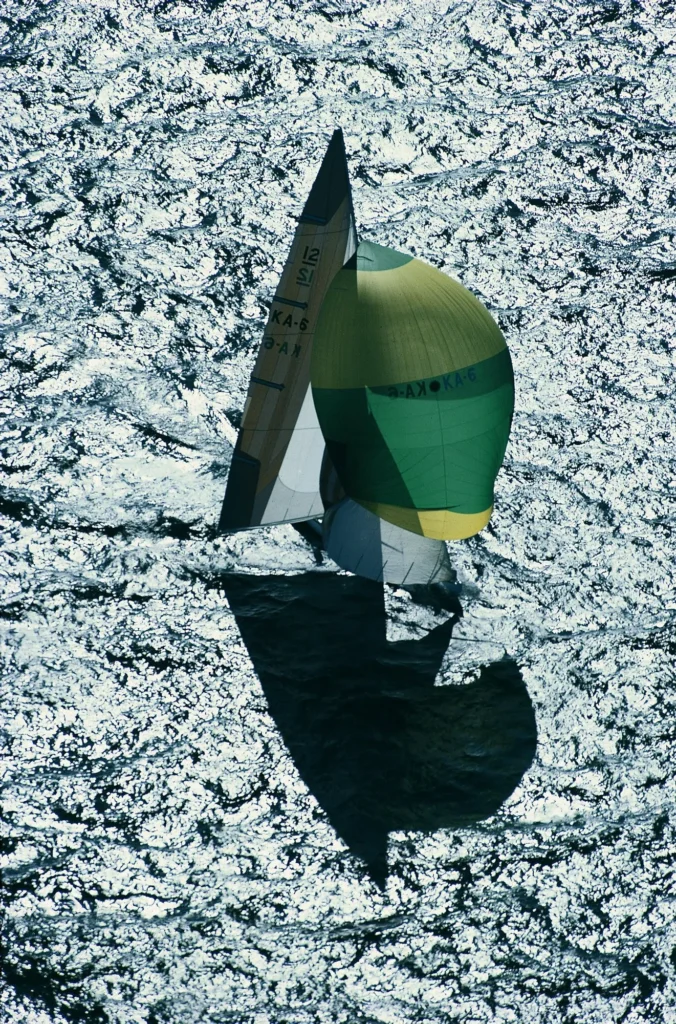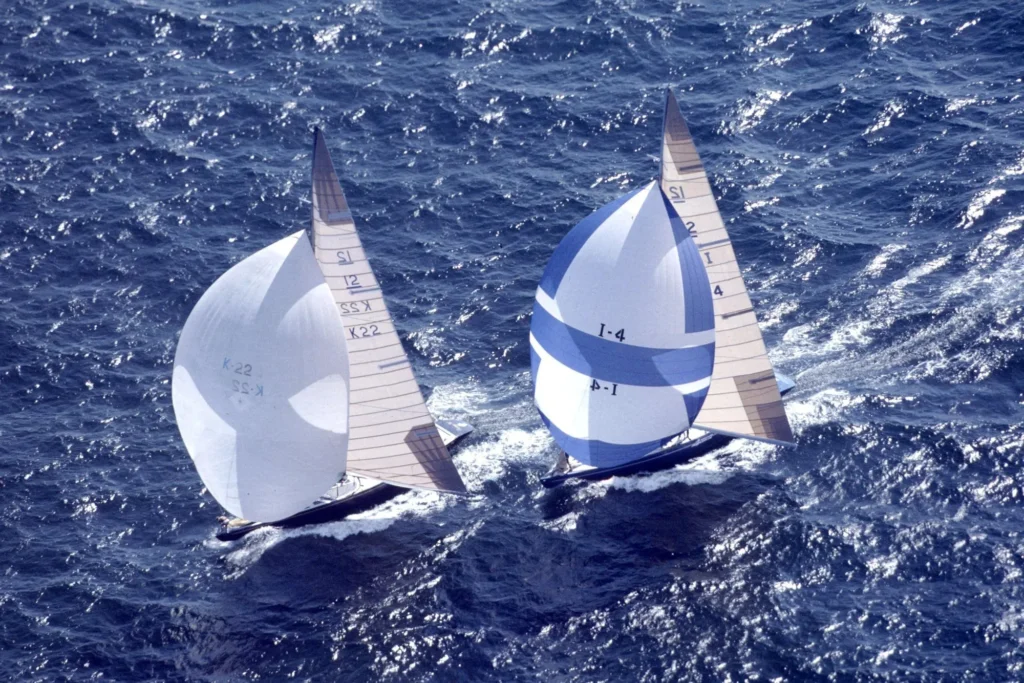1983 America’s Cup
Liberty Vs. Australia II
The 1983 America’s Cup, held in the historic waters off Newport, Rhode Island, remains one of the most celebrated and transformative events in the history of yacht racing. This 25th challenge for the oldest trophy in international sport marked the end of the longest winning streak in history and introduced revolutionary changes in yacht design that would forever alter the landscape of competitive sailing.
The Defender: Liberty (USA)
The United States defender, “Liberty,” was skippered by Dennis Conner, a name already etched in America’s Cup lore for his previous successes. Designed by Johan Valentijn and built by Minneford Yacht Yard, “Liberty” represented the culmination of American innovation within the constraints of the 12-meter class rules. Conner, known for his intense dedication and competitive drive, aimed to continue the United States’ 132-year undefeated streak in the America’s Cup, a symbol of American maritime dominance.

The Challenger: Australia II (Australia)
The challenger, “Australia II,” represented the Royal Perth Yacht Club and was helmed by John Bertrand. Designed by Ben Lexcen, “Australia II” was a radical departure from traditional 12-meter designs, most notably featuring a revolutionary winged keel that significantly improved her performance, particularly in heavy seas and light winds. The innovative design was shrouded in secrecy and became the center of intense speculation and controversy. “Australia II” embodied the hopes of a nation and the cutting edge of yacht design technology.

The Races
The 1983 America’s Cup was characterized by intense competition, strategic brilliance, and a level of suspense that had rarely been seen in the event’s history. The racing series was a back-and-forth battle that showcased the skill, determination, and resilience of both crews. “Liberty” and “Australia II” faced off in a series of seven races, with the outcome hanging in the balance until the very end.
The series was ultimately decided in the seventh and final race, a nail-biting contest that is remembered as one of the greatest moments in sailing history. “Australia II” managed to overcome a deficit on the final leg of the race, executing a series of flawless maneuvers that allowed her to pass “Liberty” and cross the finish line first, clinching the victory and ending the longest winning streak in the history of sport.

Legacy
The 1983 victory of “Australia II” marked the first time the America’s Cup had been won by a challenger from outside the United States, breaking a 132-year streak of American victories and shifting the Cup to the Southern Hemisphere for the first time. The event catapulted the America’s Cup into a new era of international competition and technological innovation. The winged keel of “Australia II” became a symbol of the relentless pursuit of excellence and innovation that defines the America’s Cup. John Bertrand and his crew became national heroes in Australia, celebrated for their skill, perseverance, and for bringing the Cup “Down Under.”
The 1983 America’s Cup is remembered not just for the dramatic change in the competition’s history it represented, but also for the spirit of innovation, international camaraderie, and the sheer excitement of sailing at the highest level. It set the stage for future challenges and ensured that the America’s Cup would remain the pinnacle of yacht racing, inspiring generations of sailors and designers to push the boundaries of what is possible on the water.
Other US 12 Meters in the 1983 America’s Cup
The 1983 America’s Cup, held off Newport, Rhode Island, was notable not only for the dramatic races between “Liberty” and “Australia II” but also for the vigorous selection trials that determined the American defender. These trials featured several 12 Meter class yachts vying for the honor of defending the America’s Cup, each crewed by skilled sailors and backed by considerable technological research and development. The competition within the American camp was intense, reflecting the depth of talent and resources committed to preserving the United States’ long-standing dominance in the competition.
US Defender Trials Participants:
Liberty (US-40): Skippered by Dennis Conner, “Liberty” ultimately emerged as the defender for the 1983 America’s Cup. Conner was a seasoned veteran of America’s Cup races, having previously defended the Cup in 1980.
Defender (US-33): One of the contenders in the defender trials, “Defender” was built specifically for the 1983 America’s Cup. Despite the investment in its design and construction, “Defender” was not able to outperform “Liberty” in the trials.
Courageous (US-26): Skippered by Ted Turner in previous Cups, “Courageous” had successfully defended the Cup in 1974 and 1977. For the 1983 trials, “Courageous” was updated and entered into the selection process, bringing a storied history to the competition. Despite her pedigree, “Courageous” did not win the selection trials. Clipper (US-32): Also participating in the trials, “Clipper” was another yacht that sought to be the defender of the Cup. Like “Defender” and “Courageous,” “Clipper” competed in the selection series but did not secure the spot as the defender.
These yachts and their crews represented the pinnacle of American sailing talent and technological innovation at the time. The selection trials were as much a test of design and engineering as they were of sailing skill, with each team pushing their vessels to the limits in hopes of representing the United States in the America’s Cup.

Legacy of the Trials:
The defender trials for the 1983 America’s Cup underscored the competitive nature of the event, even before the international competition began. The trials were a showcase for American yachting, demonstrating a commitment to excellence and innovation in the 12 Meter class. While “Liberty” ultimately won the honor of defending the Cup, the other yachts and their crews played a crucial role in the story of the 1983 America’s Cup, contributing to the rich tapestry of America’s Cup history and the evolution of yacht racing at the highest levels.
Foreign Challenger Trial Participants
The 1983 America’s Cup, held off Newport, Rhode Island, was a landmark event not only because of the dramatic races but also due to the unprecedented international competition it attracted. The challenge selection series saw a diverse fleet of 12 Meter yachts from various countries vying for the opportunity to become the Challenger and face the American defender, “Liberty.” This was the first time the event featured multiple foreign challengers, making the road to the America’s Cup finals a fiercely contested battle.

Challengers in the 1983 America's Cup
Advance (Australia): Representing the Royal Sydney Yacht Squadron, “Advance” was one of the Australian contenders. Despite its efforts, “Advance” could not outperform its compatriot, “Australia II,” in the challenger selection trials.
Challenge 12 (Australia): Another Australian yacht, “Challenge 12” represented the Royal Melbourne Yacht Squadron. It was a strong competitor in the trials but ultimately did not secure the spot to challenge for the Cup.
Azzurra (Italy): Representing the Yacht Club Costa Smeralda, “Azzurra” was the first Italian 12 Meter yacht to compete in the America’s Cup. “Azzurra” brought a Mediterranean flair to the competition and showcased Italy’s growing interest and capabilities in yacht racing.
Victory ’83 (United Kingdom): From the Royal Thames Yacht Club, “Victory ’83” carried British hopes in the challenger trials. The UK had a long history with the America’s Cup, and “Victory ’83” aimed to add a new chapter by securing the right to challenge “Liberty.”
Canada I (Canada): Representing the Royal Vancouver Yacht Club, “Canada I” was Canada’s entry in the selection trials. This yacht was part of Canada’s efforts to establish a stronger presence in international yacht racing, particularly in the America’s Cup.
Sverige (Sweden): “Sverige,” representing the Royal Swedish Yacht Club, was Sweden’s contender in the 1983 America’s Cup. The participation of “Sverige” highlighted the global appeal of the Cup and Sweden’s commitment to competitive sailing.
These yachts, each representing their respective countries and yacht clubs, competed in a series of races known as the Louis Vuitton Cup, which was the challenger selection series for the America’s Cup. “Australia II” emerged victorious from this highly competitive field, earning the right to challenge the American defender, “Liberty,” in the America’s Cup finals.
The 1983 challenger trials were significant not only for their competitive intensity but also for the international camaraderie and technological innovation they showcased. Each team brought unique designs and strategies to the competition, contributing to the evolution of yacht racing and setting the stage for the global spectacle that the America’s Cup has become.
